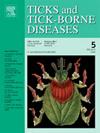在加拿大东南部,各种小型哺乳动物宿主参与了人畜共患病嗜吞噬细胞无原体的传播周期
IF 3.4
2区 医学
Q2 INFECTIOUS DISEASES
引用次数: 0
摘要
人粒细胞无形体病(HGA)是一种在北美出现的蜱传疾病,由嗜吞噬细胞无形体菌的人畜共患变异Ap-ha(人活性)引起。本研究旨在了解加拿大曲海省Ap-ha小型哺乳动物的水库能力。为了实现这一目标,研究人员于2022年和2023年6月至8月取样了野生小型哺乳动物,并采用针对msp2和16S基因的qPCR检测了Ap及其变体(Ap-ha, Ap-v1)。在两年的时间里,总共捕获了来自9个不同分类群的547种小型哺乳动物。近一半(48.2%)的小兽类携带至少1只肩胛骨伊蚊幼虫,29.3%的小兽类携带至少1只肩胛骨伊蚊若虫。与Peromyscus sp .小鼠相比,东部花栗鼠感染Ap的几率是前者的3倍(OR = 2.98, p < 0.05),红松鼠感染Ap的几率是后者的5倍(OR = 0.21, p < 0.01)。经感染后,Peromyscus小鼠和东部花栗鼠的平均感染率分别为6.8% (CI95: 24.9 ~ 48.7)和52.9% (CI95: 16.7 ~ 89.1)。在90%(109/121)的感染小兽类中鉴定出Ap变异,均为Ap-ha株。综上所述,东部花栗鼠和Peromyscus小鼠应被认为是导致加拿大无形体病传播和出现的宿主。这项研究还证实了Ap-ha变异在加拿大东南部宿主和蜱虫群落中的传播。本文章由计算机程序翻译,如有差异,请以英文原文为准。
Various small mammal hosts are involved in the transmission cycle of zoonotic Anaplasma phagocytophilum in Southeastern Canada
Human granulocytic anaplasmosis (HGA) is a tick-borne disease emerging in North America, caused by the zoonotic variant Ap-ha (human active) of the bacterium Anaplasma phagocytophilum. This research aimed to understand the reservoir competency of small mammals for Ap-ha in the province of Québec, Canada. To achieve this aim, wild small mammals were sampled from June to August in 2022 and 2023 and tested for Ap and its variants (Ap-ha, Ap-v1) using qPCR targeting the msp2 and 16S genes. In total, 547 small mammals from nine different taxa were live captured across two years. Nearly half (48.2 %) of small mammals carried at least one Ixodes scapularis tick larva and 29.3 % carried at least one I. scapularis nymph. The odds of Ap infection were three times higher in eastern chipmunks (OR = 2.98, p < 0.05) and five times lower in red squirrels (OR = 0.21, p < 0.01) when compared to Peromyscus spp. mice. When infected, Peromyscus mice and eastern chipmunks transmitted the infection on average to 6.8 % (CI95: 24.9–48.7) and 52.9 % (CI95: 16.7–89.1) of feeding larvae, respectively. An Ap variant could be identified in 90 % (109/121) of infected small mammals, all of which were the Ap-ha strain. In conclusion, eastern chipmunks and Peromyscus mice should be considered as reservoir hosts contributing to the transmission and emergence of anaplasmosis in Canada. This study also confirms the circulation of the Ap-ha variant within host and tick communities in Southeastern Canada.
求助全文
通过发布文献求助,成功后即可免费获取论文全文。
去求助
来源期刊

Ticks and Tick-borne Diseases
INFECTIOUS DISEASES-MICROBIOLOGY
CiteScore
6.90
自引率
12.50%
发文量
185
审稿时长
6-12 weeks
期刊介绍:
Ticks and Tick-borne Diseases is an international, peer-reviewed scientific journal. It publishes original research papers, short communications, state-of-the-art mini-reviews, letters to the editor, clinical-case studies, announcements of pertinent international meetings, and editorials.
The journal covers a broad spectrum and brings together various disciplines, for example, zoology, microbiology, molecular biology, genetics, mathematical modelling, veterinary and human medicine. Multidisciplinary approaches and the use of conventional and novel methods/methodologies (in the field and in the laboratory) are crucial for deeper understanding of the natural processes and human behaviour/activities that result in human or animal diseases and in economic effects of ticks and tick-borne pathogens. Such understanding is essential for management of tick populations and tick-borne diseases in an effective and environmentally acceptable manner.
 求助内容:
求助内容: 应助结果提醒方式:
应助结果提醒方式:


